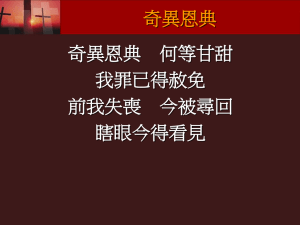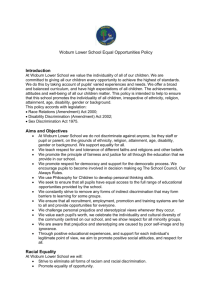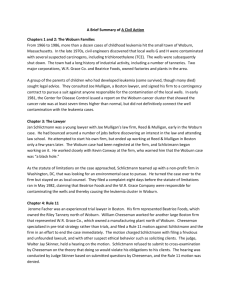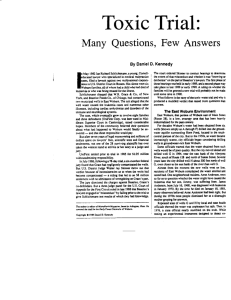Hailing end of an error The Boston Globe
advertisement
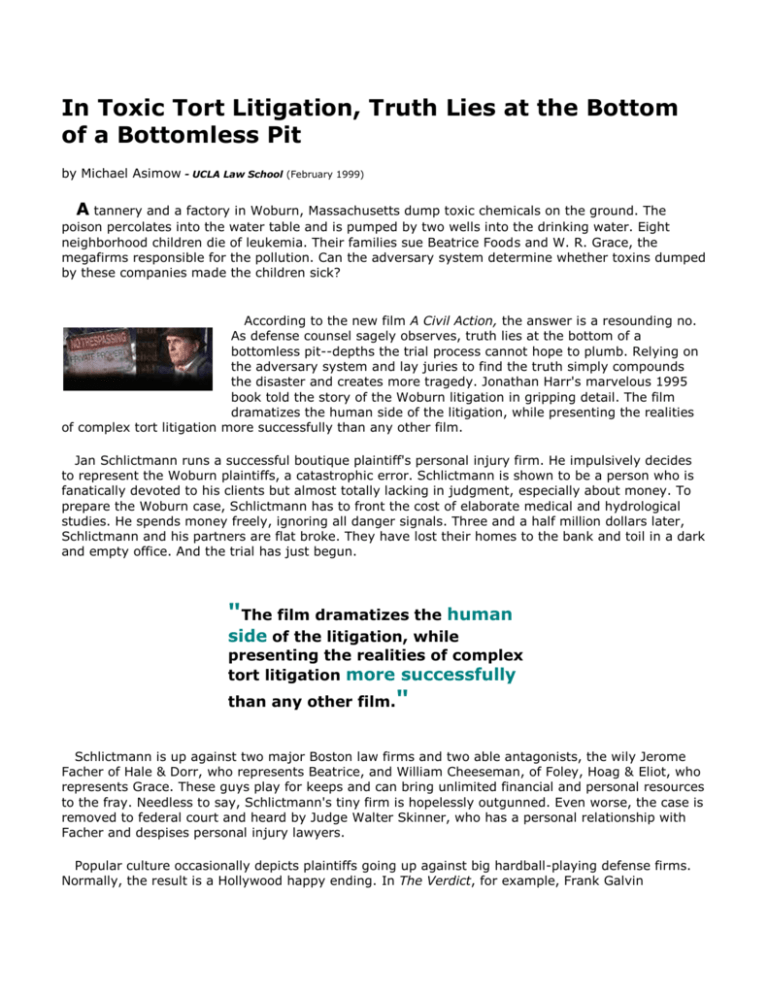
In Toxic Tort Litigation, Truth Lies at the Bottom of a Bottomless Pit by Michael Asimow - UCLA Law School (February 1999) A tannery and a factory in Woburn, Massachusetts dump toxic chemicals on the ground. The poison percolates into the water table and is pumped by two wells into the drinking water. Eight neighborhood children die of leukemia. Their families sue Beatrice Foods and W. R. Grace, the megafirms responsible for the pollution. Can the adversary system determine whether toxins dumped by these companies made the children sick? According to the new film A Civil Action, the answer is a resounding no. As defense counsel sagely observes, truth lies at the bottom of a bottomless pit--depths the trial process cannot hope to plumb. Relying on the adversary system and lay juries to find the truth simply compounds the disaster and creates more tragedy. Jonathan Harr's marvelous 1995 book told the story of the Woburn litigation in gripping detail. The film dramatizes the human side of the litigation, while presenting the realities of complex tort litigation more successfully than any other film. Jan Schlictmann runs a successful boutique plaintiff's personal injury firm. He impulsively decides to represent the Woburn plaintiffs, a catastrophic error. Schlictmann is shown to be a person who is fanatically devoted to his clients but almost totally lacking in judgment, especially about money. To prepare the Woburn case, Schlictmann has to front the cost of elaborate medical and hydrological studies. He spends money freely, ignoring all danger signals. Three and a half million dollars later, Schlictmann and his partners are flat broke. They have lost their homes to the bank and toil in a dark and empty office. And the trial has just begun. "The film dramatizes the human side of the litigation, while presenting the realities of complex tort litigation more successfully than any other film." Schlictmann is up against two major Boston law firms and two able antagonists, the wily Jerome Facher of Hale & Dorr, who represents Beatrice, and William Cheeseman, of Foley, Hoag & Eliot, who represents Grace. These guys play for keeps and can bring unlimited financial and personal resources to the fray. Needless to say, Schlictmann's tiny firm is hopelessly outgunned. Even worse, the case is removed to federal court and heard by Judge Walter Skinner, who has a personal relationship with Facher and despises personal injury lawyers. Popular culture occasionally depicts plaintiffs going up against big hardball-playing defense firms. Normally, the result is a Hollywood happy ending. In The Verdict, for example, Frank Galvin overcomes alcoholism and incompetence, as well as the defense's dirty tricks, to win a medical malpractice case--but only by chicanery and incredible luck. In Class Action, Jedediah Ward wins an exploding automobile case against a big firm that employs all sorts of unethical tactics--but only because a defense lawyer betrays her client. On TV's The Practice last year, Lindsay Dole somehow gets a cigarette case to the jury and wins bigtime. And in John Grisham's The Runaway Jury, another cigarette case is successful, despite defense chicanery, but only because of outrageous jury misconduct. In The Rainmaker, a novice attorney overcomes the dirty tricks of skilled defense counsel to win a monster verdict. The film returns to the reality level at the end, however: the money evaporates when the defendant files Chapter 11. A Civil Action stands alone as the most realistic film about a complex civil trial ever made. An underfunded and outmanned personal injury firm is eaten alive by its big firm adversaries. No happy ending here. A Civil Action dramatizes the gritty details of civil litigation better than any other film. Discovery, for example, is shown as it really is--costly, tedious, and exhausting. With nobody to cover the endless depositions for him, Schlictmann gets worn down and loses his temper. The discovery process does turn up one truthful witness, however--a Grace employee who witnessed the dumping. The rest of the defense witnesses claim they never heard or saw any dumping at all. Class Action and The Rainmaker also had discovery sequences, but they did not capture reality nearly as well. Similarly, the film graphically depicts the frightening world of settlement negotiations. The Verdict also contained a fine settlement sequence, in which another biased judge tried to browbeat the plaintiff's lawyer into taking a lowball settlement offer. A Civil Action is better, because it focuses on the very real and scary problems of deciding how much to ask for and how to get to the bottom line. By grossly misjudging the value of his case, Schlictmann dooms his clients to a jury trial of a hideously complex case. Judge Skinner trifurcates the issues and requires the jury to answer detailed interrogatories. The first phase concerns whether the companies dumped toxic waste and whether it migrated to the wells. The second phase concerns whether toxins in this concentration can cause leukemia. The third phase concerns plaintiffs' damages. Splitting up the issues is not uncommon in complex cases, because it simplifies the trial process. If plaintiff loses in any phase, the trial stops. However, the timing of Judge Skinner's critical ruling (just before trial begins) seems dubious. More important, the film shows how devastating the process of splitting up the issues can be to the plaintiff. The jury never gets to hear the parents testify about the agonizing deaths of their children--the evidence that would have made all the difference (and which Facher vowed the jury would never hear). Instead the jury endures highly technical expert testimony and perjured accounts of whether any dumping ever occurred and must answer mysterious sets of interrogatories about the precise dates that dumping and well contamination might have occurred. . Facher is a master of a typical defense tactic: the relentless use of evidentiary objections. Indeed, he tells his trial tactics class at Harvard that if you fall asleep during a trial, wake up objecting. The result is that Schlictmann never develops any momentum in the presentation of his case. The constant wrangling over evidence distracts and frustrates the jury. Once more, the adversary system is shown as the enemy of truth finding. The result of the trial was disaster for the plaintiff. Because of consistent perjury by the owner and employees of the tannery owned by Beatrice, Schlictmann cannot prove that it dumped anything. The jury verdict in phase 1 therefore is for Beatrice but against Grace. Even the favorable Grace verdict contains some very unfavorable findings about the dates of contamination, raising the definite possibility that Grace could avoid phase two. Desperate and out of money, Schlictmann is browbeaten into accepting a low-ball settlement offer from a Grace executive who handles the negotiation masterfully. Schlictmann's clients turn against him, his law firm breaks up, and he has to file for personal bankruptcy (we see the deeply humiliating bankruptcy hearing). His life and career are shattered. Yet, there is more. After the trial, Schlictmann stumbles on evidence that the tannery owner removed large volumes of toxic waste from the site. This leads to discovery of clear evidence that the tannery owner committed perjury at the trial. Nevertheless, the apparently biased Judge Skinner refuses to grant a new trial against Beatrice. "When a biased judge and plenty of perjury are mixed into the brew, the outcome can only be more victims and more disaster but little or no justice." Here the film pulls its punch by not implicating Beatrice's attorney. According to the book, what actually happened was that Beatrice failed to turn over a consultant's report that would have allowed Schlictmann to fill the holes in his case against Beatrice. The First Circuit's decision states that Schlictmann requested all such reports and Facher's firm replied that none existed. Anderson v. Cryovac, Inc., 862 F.2d 910, 927-28 (1988). If true, this seems like serious discovery misconduct. I don't know why the filmmakers fudged this part of the tale, but the full story would have deepened the film's critique of the adversary system. The adversary system and jury trials may produce an acceptable brand of justice. Perhaps it's the way to go in criminal law, where we willingly tolerate inefficiency and we seek a community judgment on the defendant's conduct. But the adversary system, which consists of teams of attorneys trying to hammer each other and conceal as much of the truth as they can, is hopelessly inept when employed to discover truth in matters of scientific controversy. Does anyone believe that justice is served by relying on adversarial lawyers, passive and inexpert judges, and lay juries to resolve complex and inherently unanswerable scientific questions? It's bad enough when the two sides are equally matched, but the situation is utterly hopeless when one side is vastly outgunned. When a biased judge and plenty of perjury are mixed into the brew, the outcome can only be more victims and more disaster but little or no justice. Synopsis of Anderson v. W.R. Grace Background of a Civil Action http://www.law.seattleu.edu/Centers_and_Institutes/Films_for_Justice/About_the_Case.xml This story begins in 1972, as a lone woman's search for answers in Woburn, Massachusetts, a working class city with a population just under 40,000. Located twelve miles north of Boston, Woburn is a legacy of being a center of industrial and chemical production since its founding in 1642. In the 1850's, it became a central place for leather-tanning factories. In the early 1900's, chemical factories producing arsenic-based insecticides, textiles, paper and animal based glues moved to Woburn. Jimmy Anderson was four years old when doctors told his mother Anne that Jimmy had a rare form of childhood cancer -- acute lymphocytic leukemia. After Jimmy's diagnosis, Anne began to hear about other children in her neighborhood who had also contracted this rare disease. Donna Robbins, who belonged to the same church as Anne, her son Robbie, also had leukemia. The Zona's son Michael, living down the block from Anne - The Toomey's son, Patrick; all these children had the same rare form of leukemia. Twelve children had leukemia, eight of them within a 1⁄2 mile radius, six of them living almost next door to each other. These eight families in the same neighborhood in Woburn discovered that they all had something in common -- that their children were afflicted with this rare and fatal illness. Suspicions about the Woburn Water However, Anne Anderson believed that they had something else in common. The water. The water in Woburn had long been suspect for its color and bad taste, and Anne thought that it might be the cause of the children's illnesses. But her questions about the water were met with disbelief by doctors, city officials, and even some friends who doubted that such a thing was possible. Then other health problems of family members surfaced-skin rashes, vision difficulties, miscarriages, headaches. Anne Anderson persisted in her claim that it was the water. The idea that Anne Anderson had about the water no longer seemed so crazy. From a lone voice of one, Anne persuaded others-until there was a united voice of the Woburn families who also wanted answers. Could the drinking water be the cause of the children's leukemia? Five years went by. City, state and federal officials ignored them. Then a breakthrough -- In 1979, the Woburn Times, a local newspaper, reported that 184 buried barrels that had contained chemicals had been discovered near to the site where the City of Woburn had drilled two wells, G and H for drinking water. This area was in proximity to industry and close to the Aberjona River. The wells were tested. But the chemical in the barrels didn't match. However, the officials did find something else -- dangerous levels of Trichloroethylene, TCE, and other chemical solvents. TCE is a common groundwater pollutant, known to cause neurological disorders, cell mutations, liver damage and cancer in laboratory animals. How did TCE get into these drinking water wells? Who was responsible? Was TCE the leukemia causing agent in the children? Could the wells supplying the drinking water to the East Woburn neighborhood be spawning a leukemia cluster? The Woburn wells G and H closed in 1979. But the leakage and damage already had been done. Enter State environment officials and the EPA. Further water testing. The EPA began drilling test wells into the aquifer. The EPA issued a preliminary report that confirmed that there was widespread contamination northeast of the wells G & H, close to where three companies were located - W.R. Grace, Beatrice Corporation, and the Unifirst Corporation - they all had industrial plants in proximity to the Woburn wells. But the EPA at this time did not identify these companies as being the wrongdoers. The Anderson Case Anne Anderson and the Woburn families still had no answers. Sixteen children would die before any action was to take place. The Woburn family stories became submerged in the bureaucratic workings of governmental agencies. Frustrated, Anne Anderson and the other families in 1980 turned to a young lawyer named Jan Schlichtmann. Jan Schlichtmann, just 30 years old who specialized in medical malpractice and product liability cases was hesitant to take the case. Schlichtmann, in a five lawyer firm, was concerned with the difficulty of scientific proof both in the pollution of the land and groundwater. The difficulty with scientifically linking the chemicals to the cause of leukemia and other diseases was daunting. Schlichtmann associated a public interest law firm, Trial Lawyers for Public Justice. Finally, Schlichtmann, with the assistance of this public interest firm, agreed to take the case. Later, Professor Charles Nesson, of Harvard Law School, a specialist in Evidence joined Schlichtmann's trial team. The Woburn families soon learned that the legal system also did not provide quick answers. Another two years went by before the suit was filed. It was then 1982, and by the time that Schlichtmann filed a complaint, both Jimmy Anderson and Robbie Robbins had died. The families' lawsuit alleged that two companies in Woburn had improperly disposed of chemicals, contaminating two municipal wells, and causing the deaths of the children. One company, W.R. Grace & Company, of New York, owned and operated the Cryovac Division manufacturing plant which produces equipment for the food-packing industry and used chemical solvents to clean tools and dilute paint. The Cryovac plant is just 2,400 feet northeast of the Woburn wells G & H. Attorney William Cheeseman and Michael Keating, senior partners in the 110 member law firm, Foley, Hoag and Eliot represented Grace. Both Harvard Law school graduates were used to managing complex cases. Cheeseman, a specialist in pretrial, oversaw this part of the case; Michael Keating became the chief trial attorney. The other company, a tannery called the John J. Riley Tannery, was owned by Beatrice Foods. Beatrice Foods Company from Chicago, in 1978, had purchased the John J. Riley Company tannery and an adjacent 15 acre unoccupied property from John J. Riley Jr. In 1983 Beatrice sold the tannery and 15 acres back to Riley while Beatrice retained legal liability for environmental matters. Schlichtmann charged that the 15 acres were contaminated by the tannery by dumping chemicals that flowed about 700 feet northeast into wells G & H. Beatrice was represented by Jerome Facher, an experienced partner who specialized in litigation in the distinguished 244 lawyer Boston firm, Hale and Dorr. The Anderson case was assigned to United States District Judge Walter Jay Skinner; also a Harvard Law School alumnus. Judge Skinner had been in private practice but was best known for his role as a prosecutor in the State of Massachusetts Attorney General's office fighting political corruption. He was used to being in the throes of attack and controversy. However, as a judge, he had a reputation for being fair and honest. Nevertheless, the war between the parties, seemed to intrude into the courtroom; often, pulling the Judge into the controversy. Pretrial Phase of Anderson Discovery in the lawsuit occupied the next four years. Dozens of pretrial motions filed and argued beat a zigzag course of wins and loses for each side in the lawsuit. They were time consuming, costly and combative. The case was a paper war fought out in the courtroom, press, and TV. The pages of discovery multiplied beyond the imagination of most seasoned lawyers. During the four years, 130 witnesses were examined, yielding 24,000 pages of documents. According to Mr. Facher, they were 60 feet high, equal to a three story building. Not only was the suit hard fought, but the lawyers had differing styles and philosophy of the civil justice system. The case was now immensely complex. The Judge wanted the case streamlined. With the defendants urging, Judge Skinner decided to "bifurcate" the case. This meant that the case was to be tried in three parts. First was the hydrological part of the case, which became known as "the waterworks". Next would be the medical part: did the chemicals cause the injuries to the plaintiffs; followed by the remedy phase-damage assessment. The Trial: Phase I Phase one of the trial began in March, 1986. A jury of six with two alternates was selected. Among the jurors was Jean Coulsey, a nurse, and part-time fork lift operator. No one on the jury had expertise with the scientific issues that were in Phase I. Plaintiffs in this first phase had to prove that Grace and Beatrice were responsible for the pollution -- did the companies dump the chemicals onto the ground? If they did dump, were the chemicals the same as those chemicals found in the wells? What amounts of chemicals were found on the defendants' property? Could these toxic chemicals have traveled from the defendants' property through the groundwater to the Woburn city wells? The proof at trial was a battle between the hydrology experts. None of the plaintiff families would testify during this part of the case. In fact, no plaintiffs were present in the courtroom. At the end of the testimony, as part of their verdict, the jury was given questions to answer as to their findings. If they responded consistently and affirmatively, then the trial would proceed to the second phase: whether the chemicals caused the cancer and the other health problems of the plaintiffs. Verdict and Decision on Phase I The jury returned a verdict in July, 1986. They responded that there was insufficient evidence against Beatrice; that W.R. Grace had negligently contaminated the wells. However, the jury could not determine when W.R. Grace chemicals had contaminated the wells. Judge Skinner then dismissed the case against Beatrice. As to W.R. Grace, the Judge suggested that he more than likely would grant a new trial because the verdict was inconsistent with the answers to the interrogatories as to when the wells became contaminated. With this split verdict and the potential ruling by Judge Skinner, there was an incentive for the plaintiffs and defendant W.R. Grace to settle. Eventually, Grace settled with the plaintiffs for approximately 8 million, although the company denied any wrongdoing. Phase one had lasted 78 days. The trial never proceeded beyond this phase. But the case was not over. Subsequent Proceedings In 1987, Schlichtmann filed an appeal. He discovered that a drilling report, known as the Yankee report, had not been given to him by Beatrice attorneys during the discovery part of the case. Schlichtmann argued that the outcome against Beatrice might have been different. This subsequent development occupied two more years in litigation before Judge Skinner and the Court of Appeals. Ultimately, the Court of Appeals ruled against the plaintiffs on this issue. A Civil Action While the case was moving through its slow paces, at Professor Nesson's suggestion, Schlichtmann, with the plaintiffs consent, allowed Jonathan Harr to follow the plaintiffs' team throughout the proceedings. Jonathan Harr, an experienced journalist-writer, for five long years, shadowed the plaintiffs' attorney Schlichtmann, read the entire pretrial record, and generally was a fly on the wall at Schlichtmann's law firm. After the trial, Harr interviewed everyone and anyone who would talk to him. Then Harr sat down to write. "A Civil Action" was Harr's nine year journey. This best selling book established the Anderson case as a noteworthy civil case in academic circles. When Anne Anderson refused to accept that her son Jimmy and other children living in Woburn, Massachusetts had been stricken with leukemia purely by chance, she set in motion a process that is still unfolding. That chain of events according to a number of educators changed the landscape of environmental law, changed Americans' view of their legal system and changed the way that law and other disciplines are taught to students around the country. The story of the trial, at least one version of it, has been told through the legal system. The best-selling book, A Civil Action by Jonathan Harr tells the plaintiffs' story. A Hollywood movie (by the same name) is a shorter version about the Woburn story and runs the gamut from tragedy to Travolta. (John Travolta plays the role of Jan Schlichtmann, and Robert Duvall stars as Jerome Facher in the Hollywood movie.) Despite the coverage in the media of many aspects of the story, and the retelling by individuals, many of whom are closely connected with the case, there are stories that have yet not been told. The Videotapes: Lessons From Woburn In 1998-1999 Marilyn Berger and Henry Wigglesworth, both from Seattle University Law School, interviewed the central participants in the Anderson case: The judge, the plaintiffs' and defense attorneys, the parties, the jurors, the witnesses, and the author of the book. They spoke frankly about their experiences, perceptions, and insights. Collected items included documents, artist sketches of the trial, and photographs. With the permission of the participants, the interviews were videotaped. Over the next few years, the 35 hours of videotaped interviews were edited. Three well known educators agreed to narrate the three videotapes. The purpose of this project was for the participants to comment in their own words about the Anderson case; some speak about the Anderson case for the first time. And we now can hear these untold stories. The participants express remarkably different views of the judicial system. We hope that their views will spawn discussion of the legal and moral questions about the case and the trial. We believe there are lessons to be learned from this complex litigation about the adversary system, procedural rules, and rules of conduct. This reinforces the notion that each of us must decide what purpose the judicial system should serve, and whether that purpose was served in the Anderson case. Hailing end of an error The Boston Globe No one in Woburn mourns demolition of the plant that spurred lawsuit in leukemia cases By Alexander Reid, Globe Staff | August 6, 2006 Woburn is losing a landmark, of sorts, but no one is shedding any tears. The story is well known by now. For years, W.R. Grace & Co. operated a machinemanufacturing plant just off Washington Street in East Woburn. In 1982, eight families sued the company, alleging that pollution from the site had caused leukemia in seven children and one adult. Grace settled, agreeing to pay $8 million without admitting any wrongdoing. The case spawned a best-selling book, ``A Civil Action," and later a popular movie, starring John Travolta. Through it all, Grace's factory has remained intact, secluded on an asphalt lot behind a locked chain-link fence. But today, with redevelopment possibilities in the offing, the parcel is ripe for reuse. Demolition crews have spent the past month maneuvering bulldozers and heavy machinery to clear away the factory's remnants, in a process that goes a long way toward diminishing a stigma that has hovered over the property like a dark cloud. To Mayor Thomas L. McLaughlin, the work signals a symbolic break with a notorious past. ``We feel like we're turning a page of history," he said. ``Woburn has recovered from the controversy and bad publicity associated with the property, though there is still some remediation that has to be carried out by W.R. Grace. Having that building demolished helps us put the controversy behind us." Representatives from W.R Grace were on site recently, surveying the progress of the demolition. Maryellen C. Johns, a senior project engineer, said the work is expected to be completed by the middle of next month. As the work progresses, the company has conducted air-quality tests with equipment posted around the perimeter of the site. Johns also said that soil samples would be taken and evaluated before the demolition is declared complete. Grace will maintain ownership of the property and will be responsible for ongoing cleanup of ground water on the site, Johns said. ``The building will be gone, but W.R. Grace still has a commitment to cleaning up and monitoring the ground water," she said. The property sits on the busy Washington Street thoroughfare, along a corridor populated by office complexes, light industry, and retail establishments. The Woburn Mall and Interstate 128 are both less than a mile away. The proximity to major roads and highways is a chief reason that Decathlon USA, a division of a French sporting goods company, has chosen the property as the site of a flagship store with retail and office space. The company has proposed a 96,000-square-foot building, with 79,000 square feet of retail space and 17,000 square feet of office space. The store would also include a playground and open space for equipment demonstration. Parking would accommodate 500 cars. The company now must obtain permits from state and local regulators. Chief among these is a request by Decathlon to change the zoning from office park to a business interstate designation. Public hearings have begun, and the Planning Board supported the zoning change Tuesday night. The matter now goes to the City Council, which will convene public meetings on Aug. 14 and 15 to consider the request. Jean Marc Lemiere, a spokesman for Decathlon, said the company must also obtain approval from the city's Conservation Commission and the Massachusetts Highway Department. Decathlon has proposed a $2 million traffic-mitigation package that would, among other things, widen a section of Washington Street and install new traffic lights to manage the traffic volume that the new store will generate. Lemiere said Decathlon sees a huge retail potential at the location. ``The demographics of the area are very good," he said. ``We've projected a customer base of 200,000 people within a 10minute drive of that location." The store will present a far different picture than the factory, which opened on the 12-acre lot in 1960 to produce machinery. New sections and a warehouse were added several years later. Workers disposed of cleaning solvents, paints, and other waste in ditches that have been linked to contamination of drinking water wells. The land is one of five properties that make up the federal government's Superfund site in Woburn. Grace will lease the property to Decathlon, but will remain bound by its agreement with the US Environmental Protection Agency to continue the cleanup. The agreement includes operation of a water-treatment plant that is housed in a small building on the property. In addition, the company will continue to operate 16 groundwater wells that are used to capture contaminated water, before pumping it to the treatment facility. Once treated, the water is released into a nearby brook, which flows to the Aberjona River. Joseph LeMay, the EPA project manager for the site, said the company files monthly updates on its progress and will continue its obligation until the water is restored to drinking standards. ``There is still groundwater contamination, and they're still cleaning it up," LeMay said. In East Woburn, meanwhile, many people welcome the end of the factory building, said Councilor Darleen Mercer-Bruen of Ward 5. ``I'm happy to see it gone," she said. ``I've attended one funeral of someone who was involved in the lawsuit. This was a terrible, terrible chapter in our history here. ``Seeing it torn down helps us to move on," she said, ``but we should never ever forget what was done on that property." Before After
